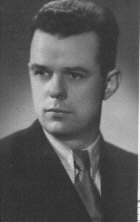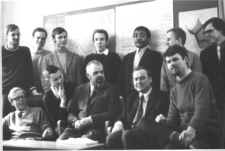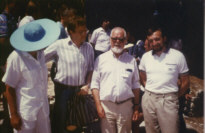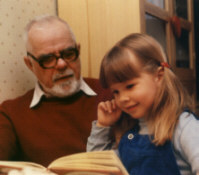
Zdzisław Szymański - how we remember him
It was a fine Sunday on September 5 last year when employees of the Division of Nuclear Structure Theory at the Institute of Theoretical Physics of the Warsaw University started off for Krzyże on Nidzkie Lake to take part in the XXVI Mazurian Lakes School of Physics, which began several days earlier. There were no lectures on Sunday. Leisure at will! When we got there, the lecturers and attendees were just coming down for a late dinner. We ate the meal together. The "Chief", Zdzisław Szymański was with us of course -- the creator and head of the Division for many years. Formally, following his retirement, he was the Head of the Division no more, but for us he was still the chief and mentor. In spite of the illness which had beleaguered him for a long time, he would not even admit the idea of not being in Krzyże. Zdzisław was the scientific and social spirit of those schools from the very beginning, when they were organized in Jeziorowskie in the sixties. He attended this time as well, ignoring his family's protests. He said he felt well and seemed relaxed. He joked around as usual. No one suspected this session to be different from all others before it...
Death came suddenly. It was a terrible, shocking blow for all of us. The only consolation was that he died without suffering and among friends, surrounded by his beloved physics. In a sense, his death during the session was the crowning accomplishment of Zdzisław's life: he died at his post, carrying on his mission to the very end. He will be missed in Krzyże and wherever else the Mazurian Schools might take place in the future. He will be missed in nuclear physics circles all over the world.
Zdzisław Szymański was born in Czarne near Włocławek on February 2, 1926. He began his schooling there before setting off for school in Poznań. The winds of war threw him to Płońsk in 1939. A young Pole in the German Reich, he worked as forced labour. He was transported to work in East Prussia from where he escaped back to Płońsk near the end of the War. After the war, in 1946, he followed in his mechanical engineer father's footsteps by attending the Mechanical Faculty of the Łódź University of Technology.
He graduated in 1950 with a Master's degree in engineering. That year he commenced the study of physics at the Warsaw University. He graduated in early 1953 with a Master's degree in that field. It is at that time he established contact with the newly formed Institute of Theoretical Physics at the Warsaw University. He began to work as a professional in 1948, while still a student at the Łódź University of Technology. In 1951 he transferred to the Warsaw University of Technology, where he worked until 1955. He worked for a short time in the Institute of Physics of the Polish Academy of Sciences and it was there he defended his doctoral thesis on the dynamics of Knudsen's gas the model of which, by the way, was useful later in nuclear physics. The thesis supervisor was Michał Łunc, an expert in fluid mechanics.
The Institute for Nuclear Research (INR) was formed in 1955. In 1956 Zdzisław Szymański commenced work there as a docent. This was when he embarked on his great adventure with nuclear physics. No other word better describes Zdzisław's approach to scientific work. He was an enthusiast. His work fascinated him. He lived it, treating it as an intellectual adventure. He worked at the Institute in various capacities until its dissolution during martial law in December of 1982. It was his only job during the seventies. He was the head of the Institute's Science Council at that time. He behaved with great dignity in that position, resisting any and all political pressures. Later, he was in close touch with the Andrzej Sołtan Institute for Nuclear Studies, formed in 1983 from one part of the INR. He went back to the INR officially in 1995, shortly before retirement.
The apprenticeship in the Niels Bohr Institute in Copenhagen played a profound role in Zdzisław Szymański's scientific career. It started in 1959, when the Institute, headed by future physics Nobel Prize winners Aage Bohr and Ben R. Mottelson formulated the concepts of modern theory of nuclear structure. The basic components of this theory are two effects of interaction between nucleons in atomic nuclei. James Rainwater of New York, a co-winner of the Nobel Prize, noticed one in 1950. He observed that nucleons outside of closed shells cause a deformation of the whole nucleus, and what follows, of the mean field of nuclear forces. Bohr and Mottelson together with American David Pines introduced the second effect -- superconductor correlations of nucleon pairs -- into the theory of nuclear structure in 1958. Zdzisław Szymański and Argentinian physicist Daniel Bčs were the first to take into account the effect of pair correlations in calculating nuclear deformations.
Today, the Bčs-Szymański method of calculating deformations has only historical significance. It has been replaced by the Strutinsky method, which was later used and developed by Szymański and his co-workers together with Sven G. Nilsson's Lund group. And so, Zdzisław Szymański took part in the creation of modern theory of nuclear structure from its very inception, contributing significantly to its development. An even greater service is that following his return to Poland he taught the theory -- directly or indirectly -- to all Polish nuclear physicists. It would not be an overstatement to call him the father of the Polish school of nuclear structure theory. This does not mean that there were no physicists in Poland working on nuclear theory before him, but no one else influenced the community so profoundly. In 1963 Szymański became a docent in the Institute of Theoretical Physics at the Warsaw University. As we already know, he became a docent in the Institute for Nuclear Research earlier. He therefore educated nuclear physicists in those two institutions. It all began with a seminar run jointly by Zdzisław and Janusz Dąbrowski in the Institute of Theoretical Physics at the Warsaw University, where a small group of people studied and attempted to understand the basic work done by the Copenhagen school. This seminar, as the joint seminar of the Division of Nuclear Structure Theory of the Institute of Theoretical Physics at the Warsaw University and the Department of Nuclear Theory at the Institute for Nuclear Studies continue to this day. Maksymilian Piłat and Stanisław Szpikowski -- two physicists from the Marie Curie-Skłodowska University in Lublin travelled to Warsaw especially to attend the seminar. Szpikowski later founded the Lublin nuclear theory group, which has become strong and numerous today. Then, there was a lecture cycle in the IA Department of Physics of the Atomic Nucleus at the Institute for Nuclear Research in Świerk. There, it was chiefly the experimenters who came to absorb knowledge. The lectures have resulted in a script bearing a lengthy title: The Effects of Action of Forces Associating Nucleons in Pairs in Atomic Nuclei. It was published as part of the "nuclear physics" series in Postępy Techniki Jądrowej [Advances in Nuclear Technique], a publication printed by the Information Centre of Nuclear Energy. The script's commonly used subtitle: "Pairing, Polish Style" was for many years the fundamental source to learn the theory of nuclear structure. Other forums at which Zdzisław Szymański disseminated the ideas and methods of nuclear structure was the Mazurian Lakes Schools of Physics, mentioned at the beginning of this article and in schools organized in Zakopane by the Cracow centre of nuclear physics.
The Polish school of nuclear structure theory began to grow. In 1964 Szymański supervised his first Ph.D. graduate -- Adam Sobiczewski, who is now a professor and member of the Polish Academy of Sciences. Later, more than ten doctoral theses were written under his supervision.
There are several factors contributing to the fact that Zdzisław Szymański is considered the father of nuclear structure theory in Poland. First was his enormous knowledge. Second a rare talent for teaching. His lectures were clear, vivid and understood by listeners who knew less about the theory. Zdzisław was fascinated by the problems he presented. He transferred that fascination onto his listeners. Third was his personality. He was an open, direct and kind man, quick to establish relationships. He was honest, never showing a hint of superiority that "I know so much more than you". There were no obvious things for him which he and others should know a priori. All questions he posed for himself and asked by his listeners he answered according to the best of his knowledge and scientific honesty. These traits caused that he was well known, valued and liked by nuclear physicists all over the world.
It was a natural turn of events that the success of the Polish nuclear physics school was followed by his own professional success. His habilitation took place in 1961 at Warsaw University. In 1969 he received the title of associate professor and in 1977 he became full professor. In 1973 he was chosen an associate member of the Polish Academy of Sciences and was made a full member in 1986. The Polish Physical Society awarded him its highest prize -- the Marian Smoluchowski medal. The law requiring a person to hold a single job forced him to choose the Institute for Nuclear Research and leave the Warsaw University in 1970. He returned to the University after eight years. In 1978 he established the Division of Nuclear Structure Theory at the Institute of Theoretical Physics of the Warsaw University which he headed until his retirement in 1996.
This is not the place for a detailed discussion of all of Zdzisław Szymański's scientific achievements. We shall mention only the most significant: the Bčs-Szymański method of calculating nuclear deformations has already been mentioned. At the end of the sixties, Zdzisław Szymański and Sven Gösta Nilsson together with co-workers in Warsaw and Lund were researching the properties of hypothetical super-heavy nuclei. They predicted an "island of stability" of nuclei around magic numbers -- the proton number 114 and neutron number 184. The results of their work were not only an important physical achievement in itself, but they spurred experimental research to look for super-heavy elements in nature and to create them artificially in accelerators. It is still not known whether the "double magic" nucleus with the number of protons Z=114 and number of neutrons N=184 really exists. What's more, latest calculations show that it is not certain whether the magic number really is 114. It turned out that super-heavy nuclei might also assume deformed shapes. The research program on super-heavy nuclei did result in the creation of nuclei of certain isotopes of elements with numbers of protons all the way up to Z=112. Recently, Z=114,116 and 118 may also have been obtained.
In the sixties, research began on nuclear states with increasingly higher spin. It became possible thanks to advances in technologies of accelerating increasingly heavier objects and obtaining excited nuclear states in collisions of heavy ions with large angular momentum transfer. It has been observed that in nuclear rotational bands, the moment of inertia, which actually is constant for rigid bodies will increase very rapidly at certain frequencies as a function of the square of rotation frequency (so-called up-bending). In certain cases, for a given frequency it may even increase infinitely fast, which leads to ambiguity (back-bending). Zdzisław Szymański, who at the time was working in Sweden as professor in the Scandinavian NORDITA scientific organization provided one of the possible interpretations of the phenomenon together with Swedish physicist Joachim Krumlinde. They considered it to be a phase transition between a super-conducting and normal state of nuclear matter (the effect of tearing apart of all correlated nucleon pairs). It later turned out that the phenomenon is only a weakening of super-conducting correlations, but also the alignment of nucleon spins along the angular momentum of the whole nucleus. From then on, Zdzisław focused mainly on high-spin nuclear states. The monograph entitled "Fast Nuclear Rotation" is the result of this long research. It was published in 1983.
In 1974 Cohen, Plasil and Świątecki noticed a phenomenon occurring in rapidly rotating drops of liquids. It should have also manifested itself in nuclear systems. The idea is that at a certain rotation frequency the drop suddenly changes shape from oblate to prolate or triaxial with much higher deformation (Beringer-Knox shape). In nuclear physics this phenomenon has been called super-deformation. Shell effects in atomic nuclei strongly modify this phenomenon. Groups of Polish and Scandinavian physicists with Sven Gösta Nilsson and Zdzisław Szymański playing leading roles analyzed the shell effects in fast-rotating nuclei. They determined that for certain large deformations (corresponding to a ratio of the lengths of the nucleus axes of 1:2) and a certain frequency of rotation, there appears in the spectrum of single particle states an energy gap just as between nucleon shells in the ground state. A super-deformed doubly magic nucleus would for example be that of 152Dy. It was only during the next decade that the existence of super-deformed rotational bands in atomic nuclei was determined experimentally. Discrete rotational levels -- in the very same 152Dy nucleus were observed for the first time in 1986 by Peter Twin and his co-workers. Analyzing super-deformed bands in more nuclei, it has been observed that some of them have nearly identical moments of inertia in different nuclei (identical bands). Despite many attempts, this fact has not been satisfactorily explained to this day. Zdzisław Szymański devoted much time and energy to explain this phenomenon. Death interrupted his research. He worked until the very end of his life. His last publication, of which he is a co-author is in press in Physical Review C.
Zdzisław boasted extensive international scientific contacts. He began in 1959 with the collaboration with the Niels Bohr Institute in Copenhagen. The city was always a Mecca of nuclear physics to him, a place to which he constantly returned. Somewhat later, between 1970 and 1971 he also visited other Scandinavian centres as NORDITA visiting professor, particularly the ones in Lund and Stockholm. In Lund he established close working ties with Professor Sven Gösta Nilsson's group. Nilsson created the shell model for deformed nuclei. In 1983 the Lund Institute of Technology awarded Zdzisław with an honoris causa degree in appreciation of his input into the development of the Lund centre. Not everyone knows that he was approached to make himself available as a candidate for the head of the centre after Nilsson's death. He refused. Considering the political situation of the time, he felt that he should be in Warsaw, with his students, colleagues and co-workers... In 1964 and 1965 he was in Caltech in Pasadena, working for a brief time on weak interactions in atomic nuclei and the problem of parity non-conservation. He lectured in the International Centre for Theoretical Physics in Trieste. He also kept close professional ties with France. He was a Francophil, perhaps because of his roots: his mother was of French origin. He often visited the universities in Grenoble and Strasbourg, spending several years in both. One of his last contacts was the Oak Ridge National Laboratory in the United States. Condolences after his death came from all over the world, showing the enormous influence that Zdzisław Szymański exerted on nuclear physicists.
He was not only a great scientist, but also an organizer of science, teacher and an active member of the scientific circles, not only related to nuclear physics. He never avoided performing functions in organizations. He was the vice-dean for student affairs at the Faculty of Mathematics and Physics (later the Faculty of Physics) of the Warsaw University from 1967 to 1970. In 1968 he performed a great service for the students, effectively defending them from being drafted into the army. Later he assumed the position of vice-director of the Institute of Theoretical Physics at the Warsaw University (1980-1984). He was chief editor of Nukleonika ["Nucleonics"] from 1974 to 1981. He sat in on the Scientific Council of the Heavy Ion Laboratory and the Board for Nuclear Issues with the President of the National Atomic Energy Agency. He was a member of the Nuclear Physics Board of the European Physical Society. The list of his organizational, teaching and social activities is much longer.
Our mentor, teacher, colleague, and friend is gone. This is what Aage Bohr and Ben R. Mottelson wrote in their letter of condolence to Polish physicists on the loss of Zdzisław Szymański: [He] has played such an important role in the understanding of nuclear structure and in the personal relationships within the worldwide community. His enthusiasm and appreciation of the content of scientific work and his unswerving intellectual honesty have made the contacts with him deeply rewarding and will continue to be an inspiration for us all. This inspiration was felt especially in Copenhagen where he and his pupils have contributed so much. There is no need to mention that Zdzisław's presence was and will continue to be an ever stronger inspiration for us -- his co-workers, colleagues, students and friends from Warsaw, Lublin, Cracow, as well as those scattered all over the world.
Grzegorz Rohoziński
Warsaw, May 4, 2000
Transated from Polish by Paweł Skaliński
Page last modified on December 13, 2000
About/ Zdzislaw/ Sign in/ Update/ List/ Local/ Contributions/ Contact/ Back to Home Page/ Send comments about these pages to webmaster.
Web design ©2000 by Pawel Przewlocki vel Pafcio.




